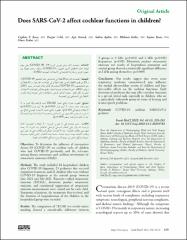| dc.contributor.author | Koca, Ç.F. | |
| dc.contributor.author | Koca,Ç.F., Çelik,T.,Şimşek,A., Aydın,S.,Kelleş,M.,Yaşar,Ş.,Erdur,Ö. | |
| dc.date.accessioned | 2022-03-10T07:08:24Z | |
| dc.date.available | 2022-03-10T07:08:24Z | |
| dc.date.issued | 2022 | en_US |
| dc.identifier.citation | Koca,Ç.F., Çelik,T.,Şimşek,A., Aydın,S.,Kelleş,M.,Yaşar,Ş.,Erdur,Ö.Does SARS-CoV-2 affect cochlear functions in children?Saudi Med J 2022; Vol. 43 (3): 259-265 | en_US |
| dc.identifier.uri | https://smj.org.sa/content/smj/43/3/259.full.pdf | |
| dc.identifier.uri | https://hdl.handle.net/20.500.12899/569 | |
| dc.description.abstract | Objectives: To determine the influence of coronavirus disease-19 (COVID-19) on cochlear tasks of children who had COVID-19 previously, and the relevance among disease seriousness and cochlear involvement by otoacoustic emissions (OAEs).
Methods: The study included 24 hospitalized children after COVID-19 diagnosis, 23 pediatrics that received outpatient treatment, and 21 children who were without COVID-19 diagnosis as the control group between June 2021 and July 2021. Transient evoked otoacoustic emission (TEOAE), distortion product otoacoustic emission, and contrlateral suppression of otoacoustic emission measurements were carried out for each child. Symptoms of patients, the treatments they received, and the duration of hospitalization of the children in the hospitalized group were recorded.
Results: The comparison of TEOAE test results under masking showed a considerable difference between 3 groups at 1 kHz (p=0.033) and 4 kHz (p=0.021) frequencies (p<0.05). Distortion product otoacoustic emission test results of hospitalized outpatient and control group showed a statistically significant difference at 2 kHz among themselves (p=0.009).
Conclusion: Our results suggest that severe acute respiratory syndrome coronavirus-2 may influence the medial olivocochlear system of children and have irreversible effects on the cochlear functions. Early detection of problems that may affect cochlear functions is a special critical task, especially in children, who are a particularly vulnerable group in terms of hearing and related speech problems. | en_US |
| dc.language.iso | en | en_US |
| dc.relation.ispartof | Saudi Med J | en_US |
| dc.rights | info:eu-repo/semantics/openAccess | en_US |
| dc.subject | COVID-19; SARS-CoV-2; cochlear; pediatric | en_US |
| dc.title | Does SARS-CoV-2 affect cochlear functions in children? | en_US |
| dc.type | Article | en_US |
| dc.authorid | 0000-0001-8990-0651 | en_US |
| dc.department | MTÖ Üniversitesi, Tıp Fakültesi, Cerrahi Tıp Bilimleri Bölümü | en_US |
| dc.institutionauthor | Koca Fırat, Çiğdem | |
| dc.identifier.doi | 10.15537/smj.2022.43.3.20210782 | |
| dc.identifier.startpage | 259 | en_US |
| dc.identifier.endpage | 265 | en_US |
| dc.relation.publicationcategory | Makale - Uluslararası Hakemli Dergi - Kurum Öğretim Elemanı | en_US |
| dc.identifier.pmid | 35256493 | |
| dc.identifier.scopus | 2-s2.0-85125981079 | en_US |
| dc.identifier.wos | WOS:000788593800005 | en_US |
| dc.identifier.wosquality | Q3 | en_US |
| dc.indekslendigikaynak | Web of Science | en_US |
| dc.indekslendigikaynak | PubMed | en_US |



















